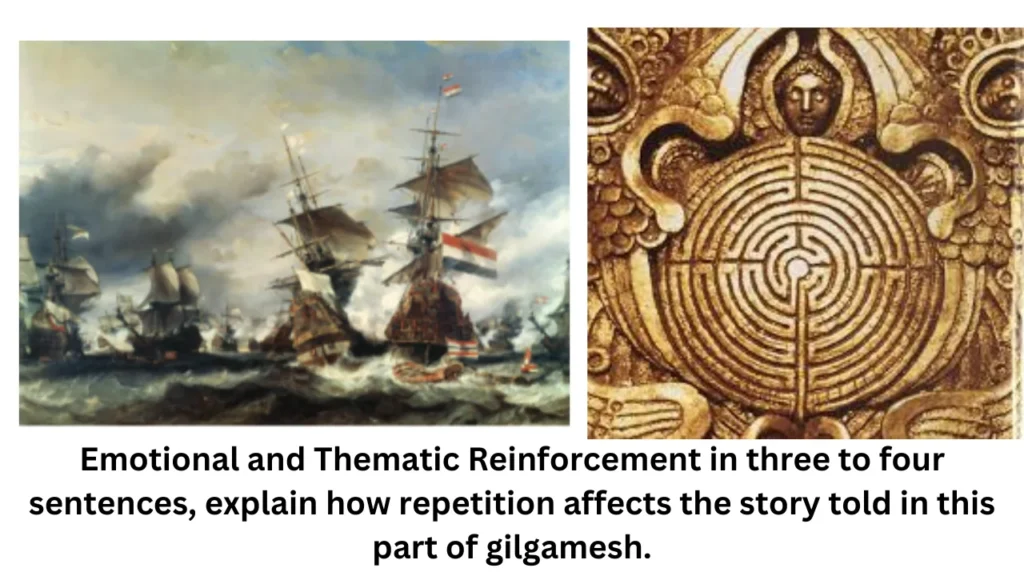In Three To Four Sentences, Explain How Repetition Affects The Story Told In This Part Of Gilgamesh.

The in three to four sentences, explain how repetition affects the story told in this part of gilgamesh. One of the oldest surviving works of literature, is rich with themes, symbolism, and narrative techniques, one of which is repetition. Repetition serves various purposes in the epic, emphasizing themes, reinforcing key messages, and creating a rhythm that shapes the storytelling. If asked “in three to four sentences, explain how repetition affects the story told in this part of Gilgamesh,” it is essential to consider how it deepens the emotional and thematic impact of the narrative.
What is in three to four sentences, explain how repetition affects the story told in this part of gilgamesh.
In three to four sentences, repetition in The Epic of Gilgamesh reinforces key themes and emotions, deepening the reader’s understanding of the story. By repeating certain phrases or events, such as Gilgamesh’s grief over Enkidu’s death or his heroic deeds, the epic emphasizes the significance of these moments. This repetition helps build tension, highlights the character’s emotional struggles, and ensures that the core messages of friendship, mortality, and heroism are constantly in focus throughout the narrative. It also contributes to the rhythm and structure of the epic, making it more cohesive and impactful.
What is Repetition in Literature?
Repetition is a literary device where words, phrases, or even entire themes are repeated throughout a story. This technique creates emphasis and allows the reader to focus on certain key elements of the narrative. In The Epic of Gilgamesh, repetition plays an essential role in reinforcing the hero’s journey, reminding the audience of critical moments in the tale. Understanding this device’s role can be fundamental when answering questions like “in three to four sentences, explain how repetition affects the story told in this part of Gilgamesh.”
Repetition in The Epic of Gilgamesh
In The Epic of Gilgamesh, repetition often appears in the form of repeated phrases, descriptions of events, or recurring motifs. When you consider “in three to four sentences, explain how repetition affects the story told in this part of Gilgamesh,” . The answer could be linked to how these repeated elements shape the reader’s experience. Repetition not only ensures that important details stay at the forefront of the reader’s mind but also connects different parts of the epic, creating a unified and cohesive narrative.
For example, in the repeated portrayal of Gilgamesh’s strength and his friendship with Enkidu. The audience is constantly reminded of these core elements that define the story. This repetition builds the central conflict and eventual resolution in the epic. Making it easier for readers to connect emotionally to Gilgamesh’s journey. Thus, when one asks “in three to four sentences, explain how repetition affects. The story told in this part of Gilgamesh,” it’s clear that repetition draws attention to the epic’s key messages and thematic core.
Emotional and Thematic Reinforcement in three to four sentences, explain how repetition affects the story told in this part of gilgamesh.

One of the primary ways repetition affects the storytelling in The Epic of Gilgamesh is through emotional reinforcement. Important moments, such as the friendship between Gilgamesh and Enkidu, are repeated to strengthen their emotional significance. When Enkidu dies, the sorrow of Gilgamesh is amplified by the repetition of certain phrases and imagery related to his grief. Repetition thus allows readers to feel the weight of his despair and the importance of his search for immortality.
If we “in three to four sentences, explain how repetition affects the story told in this part of Gilgamesh,”. We can emphasize that this technique helps to create a sense of rhythm and importance. Repetition builds tension and creates emotional connections with the audience, making Gilgamesh’s journey feel more personal and relatable.
| Repetition in Story | Purpose | Emotional Impact |
|---|---|---|
| Repeated references to Enkidu’s death | Emphasizes the grief and loss Gilgamesh experiences | Amplifies emotional depth and reinforces the theme of mortality |
| Repetitions of Gilgamesh’s heroic deeds | Reminds the reader of his god-like abilities | Highlights his hubris, which is essential to his character arc |
| Recurring dreams and visions | Foreshadow upcoming events | Builds tension and provides insight into Gilgamesh’s internal struggles |
In this context, repetition serves to deepen the thematic resonance of the story. As Gilgamesh journeys through various challenges, repetition of certain events and phrases ensures that the key themes — like friendship, mortality, and heroism — are always at the center of the reader’s attention.
Creating Rhythm and Structure Through Repetition
Another crucial role of repetition in The Epic of Gilgamesh is the rhythm it brings to the story. Epic poems often rely on repetition to create a flow that feels almost musical or rhythmic. This technique can make the storytelling more engaging and memorable. When “in three to four sentences, explain how repetition affects the story told in this part of Gilgamesh” comes up, consider how this rhythm adds to the immersive nature of the epic.
The repetition of Gilgamesh’s achievements or his moments of doubt helps to structure the story. The narrative’s pace slows at key moments, allowing readers to absorb the importance of what’s being said or done. Repetition ensures that significant moments linger in the reader’s mind, contributing to the overall flow and depth of the epic.
Symbolism Through Repetition
In The Epic of Gilgamesh, repetition is also used to emphasize symbolic elements. The recurring references to nature, gods, and death are used to highlight broader symbolic messages. For instance, the imagery of the Cedar Forest appears multiple times. Throughout the epic, symbolizing a place of danger but also of growth and transformation. This repetition connects different parts of Gilgamesh’s journey. Showing how each challenge he faces is part of a larger symbolic narrative.
Thus, if asked “in three to four sentences, explain how repetition affects the story told in this part of Gilgamesh,” . You could point out how repetition highlights the epic’s symbolic layers. By repeating references to specific symbols, the story reinforces its themes of heroism, mortality, and the human experience.
Frequently Askd Questions
How does repetition contribute to the emotional impact in The Epic of Gilgamesh?
Repetition in The Epic of Gilgamesh emphasizes key emotional moments, such as Gilgamesh’s grief over Enkidu’s death. It reinforces the depth of his sorrow and highlights the themes of mortality and loss.
Why is repetition important in the structure of The Epic of Gilgamesh?
Repetition helps create a rhythmic flow in the narrative, making it more engaging and memorable. It also connects different parts of the story, ensuring that important themes are consistently reinforced.
How does repetition affect the reader’s understanding of Gilgamesh’s character?
By repeating Gilgamesh’s heroic deeds and moments of doubt, repetition highlights his strengths and weaknesses, helping the reader understand his complex character arc and personal growth.
Conclusion
Ultimately, repetition in three to four sentences, explain how repetition affects the story told in this part of gilgamesh. One of the oldest surviving works of literature plays a crucial role in shaping the story and its themes. Whether it’s emphasizing key emotional moments, creating a sense of rhythm, or reinforcing symbolic elements, repetition deepens the reader’s connection to the narrative. This literary device makes the story more cohesive, memorable, and emotionally impactful. So, when “in three to four sentences, explain how repetition affects the story told in this part of Gilgamesh” comes up, remember that repetition helps the audience experience the story on a deeper level, emphasizing both its emotional core and thematic depth.






